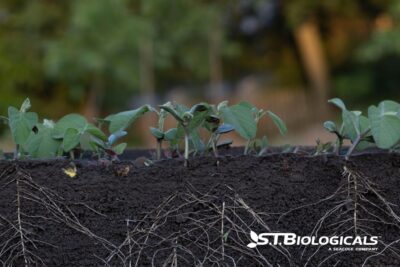Soil microorganisms are dynamic nutrient cyclers. Scientists and farmers have known for a long time that soil microbial life plays a vital role in the consumption and regeneration of resources in the environment. They are considered a major tool for efficient nutrient cycling.
Agricultural practices have used biologicals as soil amendments for many years now. But in the last decade, nanotechnology has made nutrient cycling more efficient.
There are many tools like precision farming which allows farmers to use less inputs based on acre, field, or even row needs. GPS is only one tool in the modern farmer’s toolkit.
Nanotechnology is another tool that increases the efficiency of nutrient uptake by plants. When the interplay of soil biology, nanoparticles, and nutrients is understood, precision farming can be even more cost-effective. The loss of added nutrients from leaching can be all but stopped.
Let’s look at some of the interactions going on under our feet. At the micro and nano levels, a great deal of activity takes place.
Nanotechnology and Soil Health
Fertilizers are necessary for high yields. Many commodity crops have been bred for high yields, but that characteristic means they also use a lot of nutrients. Corn and cotton are two crops that utilize a lot of chemical inputs which can degrade soils even more.
Soil biology and plants exist in a symbiotic relationship. Soil microorganisms depend on root exudates from plants for carbon. In exchange, they give the plant nutrients from the soil in plant-available forms. Most chemical inputs have to be converted to plant-available forms by soil biology. Plants do scavenge enough nutrients from chemical inputs for growth, but could crops be healthier without chemical inputs?
Here’s where nanotechnology comes in. Breaking fertilizers down into their molecular components and incorporating a nanoparticle carrier gets more nutrition into plants, less into the soil to leach, and less disruption of the plant/microorganism symbiosis.
The interactions between nanoparticle materials with soil biology are either positive or negative. It depends on the type of nanomaterial. Carbon based nano particles capture the essential work biology performs. Nano particles capture the micronized minerals in the soil and residue and hold them in a more readily exchangeable form. They also capture the biological secretions and excretions that are the catalyst for production of sugars, enzymes, amino acids which we refer to as secondary metabolites.
Nanotechnology and Abiotic Stress Factors
Increased resistance to abiotic stresses in plants is one of the biggest benefits of nanotechnology for farmers and ranchers. This is a critical benefit as we experience more extreme weather events.
A recent study of crops grown in saline environments showed significant stress reduction when silicon nanotechnology was added as a soil amendment. Plants had increased photosynthetic ability, higher relative water content and water use efficiency, an enhanced antioxidant system, and higher chlorophyll, carotenoid, and proline levels. (1)
Nutrient Cycling, Nanoparticles, and the Soil Biology Interface
Biological diversity is critical because maintaining the delicate balance of the environment and food production spells the difference between high crop yields and crop failure. Soil biology can be negatively impacted by non-carbon based nanomaterials – carbon based nanomaterials can increase soil biology diversity.
The plant microbiome includes all the microorganisms that live on all parts of the plant; leaves, stems, roots, flowers, and fruits. The microbial communities change as the plant signals with exudates what it needs. Nanoparticles can facilitate a more diverse microbiome.
Nanoparticles have unique surface properties that encourage biological activity. Wherever there are increased numbers of soil biota there is greater nutrient cycling. The biochemical and soil environments can be affected in a way that increases nutrient mineralization. This effect is mediated by plant root exudates. (2)
Nanoparticles have been shown to increase the capture of secondary metabolites by root-associated microbial activity. It matters what kind of nanoparticle is used as a carrier, the crops treated, and the diversity of the microbial community.
Nanoparticles can be extremely beneficial in agriculture. Do your due diligence. Contact a crop consultant who is familiar with nanotechnology to guide you. Nanotechnology and sustainable farming practices can lead to better soil health, more diverse microbial populations, healthier crops, and more profitable food production.
Our team at ST Biologicals works with cutting-edge nanotechnology and sustainable ag practices to benefit our farmers and society. Contact us to start planning next season. We are here to help you succeed. Soil speaks. We listen.

